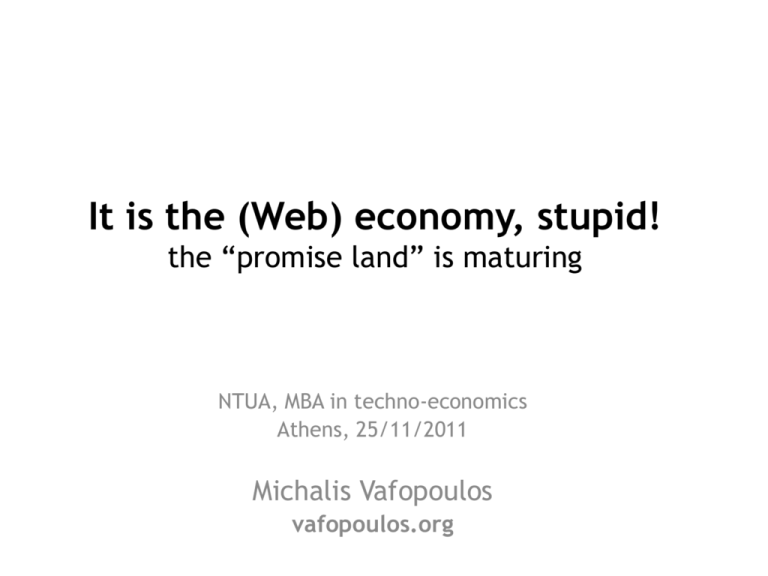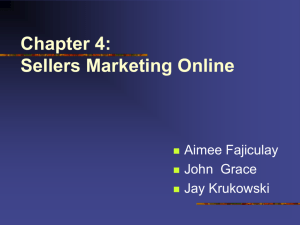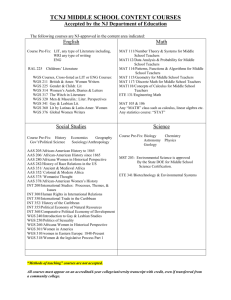It is the (Web) - Vafopoulos.org
advertisement

It is the (Web) economy, stupid! the “promise land” is maturing NTUA, MBA in techno-economics Athens, 25/11/2011 Michalis Vafopoulos vafopoulos.org The question Which are the main aspects of the Web economy? 2 It is the economy, stupid! How long takes to have 50 million users? • 38 years for telephone • 13 years for television • 4 years for Internet • 3 years for iPod • 2 years for Facebook • <1 year for Google + • ??? 3 Main issues ① Web and economics & the Web Science perspective ②Goods in the Web ③Users ④Consumption and Production in the Web ⑤Economic modeling of Web Goods ⑥Market regulation and antitrust issues ⑦Web-based development 4 the Web Science perspective ① Internet economics: the predecessor ② Partial analysis of the Web economy ③ e.g. network economics, digital goods etc. ④ Mainly focus on business implications ⑤ Issues: Auctions, e-commerce, search engines ⑥ Lately, net neutrality & excessive market power ⑦ Web science perspective – Standalone artifact – Actor-Networks Theory – How the Web transforms economy and business 5 Goods in the Web ①Data, information, knowledge ②Information goods ③Knowledge goods ④Digital goods (+ Wisdom/Ethics) 6 Information goods: definitions Definition I the good, which main market value emanates from the information it contains. Definition II anything that can be digitized (Varian) 7 Information goods: characteristics • • • • • • high fixed cost of production low marginal cost of reproduction increasing returns to scale experience good public or a private good non-rival and sometimes non-excludable 8 Information goods: issues • Versioning (e.g. s/w) • Bundling (e.g. MS office, Google?) • Pricing (e.g. discrimination) 9 Knowledge goods exogenous or endogenous inputs in production as: ①know-what (facts) ②know-why (scientific knowledge) ③know-how (skills) ④know- who (networks) 1, 2 easily reproducible 3, 4 not easily reproducible 4 more important in the Web era 10 Digital goods Bits with economic value, which are: ①nonrival ②infinitely expansible ③(Initially) discrete or indivisible ④aspatial ⑤recombinant 11 Externality ①analyzes the impact that individual decisionmaking has on the other agents ②comparison of how decision-making involves others without exchange ③Positive (i.e. education) or ④Negative (i.e. profiling) 12 Network externality Network externality: ①Some goods/services create more value when more users consume the same goods and services ②They have little or even no value if they are used in isolation (e.g. telephony) 13 Types of network externalities ①Direct (e.g. mobile phones) ②Indirect (e.g. mobile phone accessories) ③Two-sided network effects (or multi-sided platforms) (e.g. hardware-software platforms and the Google’s advertising platform) 14 Issues in network markets Network monopoly (e.g. Microsoft, Google) Possible regulatory policies: ①Divestiture of the monopoly into separate firms. ②Unbundling or wholesale access to incumbent’s facilities (e.g. Internet explorer). ③Licensing of proprietary interfaces to potentially competing platforms. 15 Network externalities in the Web Source of externalities =linking ①Web 1.0: documents (demand) ②Web 2.0: Users (supply) ③Web 3.0: structured data (dem. + supply?) Linked Data • bidirectional and massively processable interconnections among online data • enabler for existing infrastructures 16 Network externalities in the Web Negative: • lack of trust • security, • identity theft • clickjacking • spamndexing • … 17 Web Goods: definition Existing approaches fail to both capture the digital and the network dimension (aka virtualization) Web Goods are sequences of binary digits, identified by their assigned URI and affect the utility of or the payoff to some individual in the economy. 18 Web Goods Their market value stems from the digital information they are composed from and a specific part of it, the hyperlinks, which link resources and facilitate navigation over a network of Web Goods. (homework (+1): Find inferior, luxury, Giffen etc. Assumptions: income=time consumed online Price: time per bit of information in a WG) 19 Web Goods: categories • Pure: basically exchanged and consumed in the Web and are not tightly connected to an ordinary good or a service (pre-) existing in the physical world. • Non pure (e.g. car’s photo in the Web) 20 Web Goods: categories • commercial (e.g. sponsored search results) • non-commercial (e.g. Wikipedia entries) ---- • public (e.g. Linked Open Data) • private (e.g. subscription to online magazine) – financial fee – “personal data” fee – “social” or “membership” fee 21 Web Goods vs. Digital Goods • restricts non-rivalry and infinite expansibility (concurrency capacity) • initially discrete and indivisible, but • Web 2.0: micro-chunks consumption • easily edit, interconnect, aggregate and comment • extends aspatiality and atemporality from local (e.g. personal HD) to global level (e.g. downloadable file link) 22 Web Goods as commodities information and knowledge: multiple and controversial definitions Web Goods: qualify as commodities (Debreu, 1959) • stable identity (URI) • completely specified physically • temporally and spatially (reside physically in a Web server during a specific period of time) 23 Web Goods and the others… 24 Web users 25 Web economy 26 Consumption & Production in the Web Existing literature: the Web will lower prices because: ① lower search and fixed costs ② less product differentiation (e.g. location is less important) ③ “frictionless commerce” Actually: no much evidence The real transformation: More choices with less transaction costs in production and consumption. 27 Consumption in the Web ①More energetic and connected consumption – search and review, collaborative filtering – what connected consumers create is not simply content (e.g. product reviews) but context. ②Consumer coordination at large in the Web: the Amazon co-purchase network ③ Personal data abuse and regulation challenges ④Joint consumption of information and advertisements in massive scale ⑤ Moving the borders between production and consumption 28 The Amazon Co-purchase network 29 Moving the borders between production and consumption 30 Production in the Web ① Inputs: information and knowledge reloaded ② Incentives: from property to commons ③ Peer Production: decentralized inter-creativity outside the classic market ④ From mass to networked media 31 Production in the Web ① Inputs: information and knowledge reloaded ② Incentives: from property to commons ③ Peer Production: decentralized inter-creativity outside the classic market ④ From mass to networked media 32 information and knowledge reloaded the production of information is based on 3 inputs: (a) existing information (b) the mechanical means of conceiving, processing and communicating information and (c) the human communicative capacity (geography still matters in some sectors) 33 Incentives: from property to commons Property rights can be further analyzed to 4 parts: i. The right to use economic resources. ii. The right to modify form and substance of resources. iii. The right to benefit from use of resources. iv. The right to transfer resources. • Traditional economy: 1st consumers, the rest producers • Web? • the 4th P: Property, Procurement, Patronage and Peer Production (commons) 34 Peer Production: decentralized intercreativity outside the classic market ① virtuous cycle : productivity creates new knowledge, attracts new Users, increase productivity, creates new knowledge... ② A peer’s private productivity < his social productivity due to supply-side knowledge externalities. ③ Peer Production happens if Users do not take advantage of other’s knowledge sharing (free riding), but contribute to the total productivity of the community. ④ usually fails due to lack of critical mass of Editors and in cases where sharing costs are higher than the cost of atomization. 35 From mass to networked media ① de-massification of the media as a result of information overload and technological advancements (Toffler) ② In the mass media the profit-maximizing strategy is to attract attention and not to invest in production quality. ③ Networked media: Never before was possible to create, distribute, promote yourself and get feedback for your music, writings or any other online content 36 The Web function 37 Economic modeling of Web Goods ① Advertising in the Web ② The Stegeman model ③ The KKPS model ④ The Katona-Sarvary model ⑤ The Dellarocas-Katona-Rand model 38 The Stegeman model (2003): assumptions ① Navigators as consumers ② Professional Editors as firms ③ Advertisers, Professional Editors with different optimizing behavior. ④ no strategic interactions between consumers and firms, forming a totally disconnected Users graph ⑤ WGs not to be connected with hyperlinks. ⑥ The processes of production and consumption of WGs create links from Users to the Web, forming the dual Users-Web function graph. 39 The Stegeman model (2003): results ① In equilibrium, firms set access fees too high at the margin, relative to what would maximize total surplus. ② Firms also put too little quality and embed too much advertising into WGs. ③ By collectively reducing the supply of advertising, firms can often increase their own profits as well as total surplus. ④ firms rely too much on advertising as a source of revenue. 40 The KKPS model (2005) ① They first modeled the interplay of three out of four (Users-Topics-Queries-Web) ② contract Users and Queries graphs in a single entity and investigated their relationship with Topics and WGs. ③ focus on understanding how the interaction of Users with Search Engines lead to a power law Web structure 41 The KKPS model (2005) 42 The Katona-Sarvary model (2008): assumptions ① Marketing literature ② commercial Web: advertising to increase traffic and revenues, not to inform, nor to signal quality or increase brand loyalty ③ Reference vs. advertising links ④ advertising effectiveness is endogenous as it depends on the network’s structure ⑤ develop a novel approach that results scale-free patterns for in- and out-links in equilibrium ⑥ Users are divided to consumers and producers of online content and Search Engines ⑦ Consumers follow random-surfer model 43 The Katona-Sarvary model (2008): assumptions ① Producers are Professional Editors both advertisers and the media. ② Search Engines are not consider being strategic players but an auxiliary mechanism in finding WGs. ③ extended version incorporates Search Engines and Topics: tri-graph among the contracted Editors-Web graph, the Navigators and the Topics graph. 44 The Katona-Sarvary model: results ① In all equilibria, both advertising and reference links direct to higher content WGs, verifying the practical importance of in-degree criterion as the basis of many search algorithms (e.g. Google) ② Contrastingly, the pattern of out-links is different for ad. & reference links ③ WGs tend to purchase advertising links from lower content WGs. The higher content WGs prefer to create more reference out-links ④ In the presence of search engines, the above patterns become more pronounced ⑤ The degree distribution of in- and out-links is a scalefree power-law distribution with exponent 2 45 The Dellarocas-Katona-Rand model (2010): the issue ① traditional content creators (e.g. newspapers and TV) are loosing a big part of their revenue streams from User-Generated substitutes Platforms, Search Engines and Reconstructors ② raising regulation issues in free reference linking ③ “link economy” or “news.google.com” case ④ Who is monetizing links? ⑤ First model on the economic implications of free reference hyperlinks placement to content nodes 46 The Dellarocas-Katona-Rand model (2010): assumptions ① Based on the Katona-Sarvary model ② account for simultaneous and interdependent nodelevel strategic decisions about both node properties and links. ③ a reference out-link has now benefits and costs for link sources and targets. ④ Navigators maximize their utility for any bit of information per unit of attention ⑤ Aggregators maximize their pay-offs by placing links to the best available WGs. 47 The Dellarocas-Katona-Rand model (2010): results ① Links among peer content producers can increase firm profits by reducing competition and duplicate effort. ② Links only form if competition among WGs is not too tough. ③ Linking can sustain market entry of inefficient players. ④ The main benefit of Aggregators to content producers comes from traffic expansion. ⑤ The presence of Aggregators incurs social costs that must not be overlooked. 48 To be continued... ①Market regulation and antitrust issues ①Is Google the new Microsoft? ②Net neutrality ②Web-based development ③Web business models and cases ①The “Web effect” in business ②The Google model ③Linked Data business models 49 Thank you! ? Michalis Vafopoulos vafopoulos.org 50





